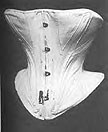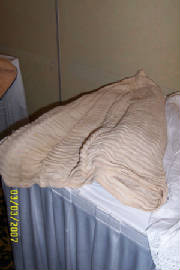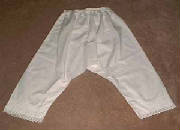|

Muslin, Pima cotton, recycled calico from an old dress Hemmed shorter than your dress. Can be plain or
decorated with embroidery or tucks.

|
| "Fancey Chemise". Godey's Lady Book, 1862 |
Chemise
The chemise is a basic undergarment. It protects your outer garment and, when wearing a corset,
serves as a buffer between your skin and the corset
Patterns are available or simple instructions for making a chemise
are available on Elizabeth Stewart Clark’s web site. Always white and can be plain with
no decoration or as elaborate with tucks or embroidery. Made of muslin, Pima cotton or fine
linen. It can be sleeveless or with sleeves and is loose bodied. Worn between the thigh and knee. There are two camps regarding how to wear it--either tucked into the drawers or left out over the drawers. This decision
is entirely up to you.
Foundation Garment Some type of foundation garment
should be worn, whether it is a fully boned corset or working stays. These garments will give you not only support but also
the the proper shape of a woman from the 1860s. Generally, a corset is appropriate for most impressions in Texas. Stays, on the other hand would be
most appropriate in a working impression or an impression of a lower class woman.

Corset Not intended to make small waist, but rather hold everything in place Gussetted or shaped Boned Usually out of coutil Could have been
different colors, usually white or beige Hooked with busk in front, laced
up back Usually store bought
|
 |
|
|
|
 |
|
Petticoats
No matter your impression or the style of your wardrobe, a petticoat will always
be used. This garment is necessary to give the proper fullness to your dress especially if you do not choose to wear a hoop.
Depending on your impression, you may want more than just one petticoat. If you are wearing hoops
a modesty petticoat under the hoops is a necessity along with one to two petticoats over the hoops. If your impression is
that of a working class or poor woman, one to two petticoats under your dress is fine.

A corded petticoat will give you a little more fullness
without wearing a hoop.
There is currently discussion on how prevalent the
corded petticoat was by the time of the Civl War. However, it does offer an alternative, especially for a lower class
impression.

Drawers (not pantalettes or bloomers)
Drawers are not a necessity; they were just coming into fashion
as the crinoline appeared. If you choose to wear them, you will find that authentically constructed drawers (without a crotch
seam) are much more convenient than modern underwear while wearing period clothes. Elizabeth Stewart Clark’s web site also includes instructions for drawer construction. Worn to just below the knee to mid-calf Optional unless wearing hoops Usually buttoned at the back Made of white cotton, muslin
or linen Can be plain or fancy with tucks, embroidery, or whitework
|
 |
|

Working stays Has shoulder straps Fabric often cotille, drill, or sateen Often
homemade Less confining than corset Cords and gussets create shape Laced either front
or back
|
|

